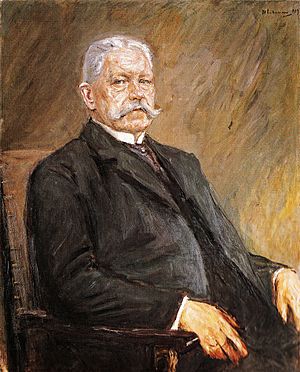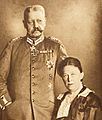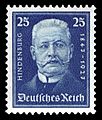Paul von Hindenburg facts for kids
Quick facts for kids
Paul von Hindenburg
|
|
|---|---|
 |
|
| 2nd President of Germany | |
| In office 12 May 1925 – 2 August 1934 |
|
| Preceded by | Friedrich Ebert (acting President Walter Simons) |
| Succeeded by | Adolf Hitler (Führer and Chancellor) |
| Chief of the German General Staff | |
| In office 1916–1919 |
|
| Preceded by | Erich von Falkenhayn |
| Succeeded by | Wilhelm Groener |
| Personal details | |
| Born | October 2, 1847 Posen, Germany |
| Died | August 2, 1934 (aged 86) Neudeck, East Prussia, Germany |
| Political party | None |
Paul von Hindenburg (born October 2, 1847 – died August 2, 1934) was a famous German army leader and politician. He was known as a field marshal, which is a very high rank in the army.
Hindenburg first retired from the army in 1911. But he rejoined when the First World War began. He became very famous after winning the Battle of Tannenberg in 1914.
He retired again in 1919 after the war ended. However, he returned to public life in 1925. He was elected as the second President of Germany.
By 1932, Hindenburg was 84 years old and not in good health. Even so, he ran for president again. He was the only candidate who could possibly beat Adolf Hitler in the election.
Hindenburg tried to stop the Nazi Party from gaining too much power. But in January 1933, he had to appoint Hitler as Chancellor. In March, he signed a law called the Enabling Act of 1933. This law gave special powers to Hitler's government.
Hindenburg died the next year. After his death, Hitler declared that the job of President was empty. Hitler then made himself the Head of State of Germany.
A famous airship called the Hindenburg was named in his honor. This airship was later destroyed by fire in 1937. Also, a special road connecting the island of Sylt to the mainland, called the Hindenburgdamm, was built during his time as president.
Contents
Becoming President: The 1925 Election
In 1925, Paul von Hindenburg was not planning to run for president. But after the first round of voting, a leader from a political party asked him to run.
Hindenburg finally agreed to join the election. He ran as an independent candidate, meaning he didn't belong to a specific political party. He was a conservative, which means he liked traditional ways.
Because he was a great war hero, Hindenburg won the election. The final vote happened on April 26, 1925.
Hindenburg's First Term as President
As president, Hindenburg tried to stay out of daily politics. He wanted to be a ceremonial president, like a symbol for the country. He liked the idea of a king or queen, but he took his promise to follow the Weimar Constitution very seriously.
Hindenburg often said he missed his quiet retirement. He also complained that politics involved things like economics that he didn't understand.
His close advisors included his son, Oskar, and two generals, Wilhelm Groener and Kurt von Schleicher. His son, Oskar, helped control who could meet with the President.
General Schleicher came up with an idea called "Presidential government." This meant the chancellor would answer to the president, not the parliament (Reichstag).
Schleicher's plan used three parts of the Constitution:
- Article 25: The President could close the Reichstag.
- Article 48: The President could sign emergency laws without the Reichstag's approval.
- Article 53: The President could choose the Chancellor.
Schleicher wanted Hindenburg to appoint a chancellor that Schleicher picked. If that chancellor needed new laws, they could use Article 48. If the Reichstag tried to stop these laws, Hindenburg could threaten to close the Reichstag and call new elections. Hindenburg didn't like this idea at first, but his son and other advisors convinced him.
The Rise of Presidential Government
The first attempt at a "presidential government" in 1926–1927 didn't work. But later, in 1929–1930, Schleicher secretly met with Heinrich Brüning, a political leader.
Schleicher then worked to break up the government that included the Social Democrats. This government fell in March 1930. Hindenburg then named Brüning as the new Chancellor.
Brüning's first action was to propose a budget with big spending cuts and tax increases. When the parliament rejected it, Brüning had Hindenburg sign the budget as an emergency law using Article 48. When the Reichstag voted to cancel the budget, Brüning had Hindenburg close the Reichstag and call new elections.
In the September 1930 elections, the Nazis gained a lot of votes, getting 17%. The Communist Party also became stronger.
Brüning continued to rule using Article 48. The Social Democrats usually didn't vote to cancel his emergency laws. They feared that another election would only help the Nazis and Communists even more.
The 1932 Presidential Election
In the first round of the 1932 election, Hindenburg was the leading candidate. However, he did not win more than half of the votes. In the second round, called a runoff election, Hindenburg won against Hitler for the Presidency.
After the election, Schleicher met secretly with Hitler in May 1932. Schleicher thought Hitler would support the new "presidential government" he was forming.
In May 1932, Schleicher convinced Hindenburg to fire General Groener as Defence Minister. This was meant to embarrass both Groener and Brüning. On May 31, 1932, Hindenburg fired Brüning as Chancellor. He replaced him with Franz von Papen, who was Schleicher's choice.
Von Papen's government openly wanted to weaken German democracy. Like Brüning's government, it was a "presidential government" that used Article 48 to pass laws.
As Schleicher wanted, Hindenburg closed the Reichstag and called for new elections in July 1932. Schleicher and von Papen believed the Nazis would win most seats and support von Papen's government.
The Nazi party did become the largest party in the Reichstag. They expected Hitler to become Chancellor. But when Hindenburg met Hitler on August 13, 1932, Hindenburg refused Hitler's demand to be Chancellor.
Hindenburg told Hitler that he could not give all government power to one party. He especially didn't want to give it to a party that was against people with different views.
Hindenburg then released a statement to the press. It made it seem like Hitler had demanded total power and the President had refused. Hitler was very angry about this statement.
When the Reichstag met in September 1932, its only action was to vote that it had no confidence in von Papen’s government. In response, von Papen had Hindenburg close the Reichstag again for elections in November 1932.
In these second Reichstag elections of 1932, the Nazis lost some support. But they still remained the largest party. More talks happened between Hindenburg, von Papen, Schleicher, and Hitler.
Hitler still demanded to be Chancellor. Hindenburg could not agree. So, von Papen suggested Hindenburg declare martial law and get rid of democracy.
Von Papen got Hindenburg's son, Oskar, to support this plan. They convinced the president to ignore his promise to the Constitution. But Schleicher stopped the martial law plan. He said it would cause the Nazi SA and the Communist Red Front Fighters to rebel. He also warned that Poland might invade, and the German army would not be able to handle it.
Hindenburg did not want Hitler to be Chancellor. But under pressure from his advisors and his son, the President decided to appoint Hitler as Chancellor. On January 30, 1933, Hindenburg officially made Hitler the Chancellor at the Presidential Palace.
The Nazi Seizure of Power
Hindenburg played a key role in the Nazi Machtergreifung (Seizure of Power) in 1933. He wasn't involved in the planning, but he didn't stop Hitler. In Hitler's first government, the Nazis were a minority. Most ministers were from previous governments. Only Hitler, Hermann Göring, and Wilhelm Frick were Nazis.
Hindenburg believed the Nazis' power was limited. He especially thought this because his favorite politician, von Papen, was the Vice-Chancellor.
Hitler's first action as Chancellor was to ask Hindenburg to close the Reichstag. Hitler wanted new elections so the Nazis could win more seats. Hindenburg agreed.
In early February 1933, von Papen had an Article 48 law signed. This law limited the freedom of the press. After the Reichstag fire, Hindenburg signed another important law called the Reichstag Fire Decree.
On March 21, 1933, the new Reichstag opened. The Nazis held a grand ceremony where Hindenburg played a main part. This event was meant to show that the new Nazi government was connected to Germany's long history.
The ceremony made many Germans, especially conservatives, feel better. They thought life would be fine under the new government. On March 23, 1933, Hindenburg signed the Enabling Act into law.
Hindenburg was still very popular, but his health was getting worse. The Nazis made sure that whenever Hindenburg appeared in public, Hitler was with him. Hitler always showed great respect to the President. Nazi propagandists hoped people would think Hindenburg liked Hitler, which would make Hitler more popular.
Hindenburg only tried to stop a Nazi law once, in April 1933. The Reichstag had passed a law to fire all Jewish civil servants.
Hindenburg refused to sign this law unless Jewish World War I veterans, Jewish civil servants who worked during the war, and Jewish civil servants whose fathers were veterans were allowed to keep their jobs. Hitler agreed to this change so the law could be signed.
Hindenburg remained president until he died from lung cancer on August 2, 1934. He passed away at his home in Neudeck, East Prussia.
The day before Hindenburg died, Hitler visited him. Hindenburg was very old and confused. He thought he was meeting Kaiser Wilhelm II, the former German emperor, and called Hitler "Your Majesty."
Hindenburg was Germany's last president until 1945. After his death, Hitler declared the office of President empty forever. He combined it with the Chancellor's job, calling himself "Leader and Chancellor." This made Hitler both Germany's Head of State and Head of government.
Burial
Hindenburg was buried in the Tannenberg memorial near Tannenberg, East Prussia. Today, this area is in Poland. However, Hindenburg had always said he wanted to be buried next to his wife. In 1945, German soldiers moved his and his wife's coffins. They did this to protect them from the approaching Soviet troops.
Images for kids
-
House of Hindenburg in Posen (Poznań) on Podgórna (former Hindenburgstrasse) street
-
The Emperor presents the Iron Cross to the Heroes of Novogeorgievsk (painting by Ernst Zimmer)
-
The Hindenburg villa in Hanover
-
Hitler and Hindenburg at the Garrison Church in Potsdam
-
The Tannenberg Memorial where Hindenburg and his wife were buried
See also
 In Spanish: Paul von Hindenburg para niños
In Spanish: Paul von Hindenburg para niños




























